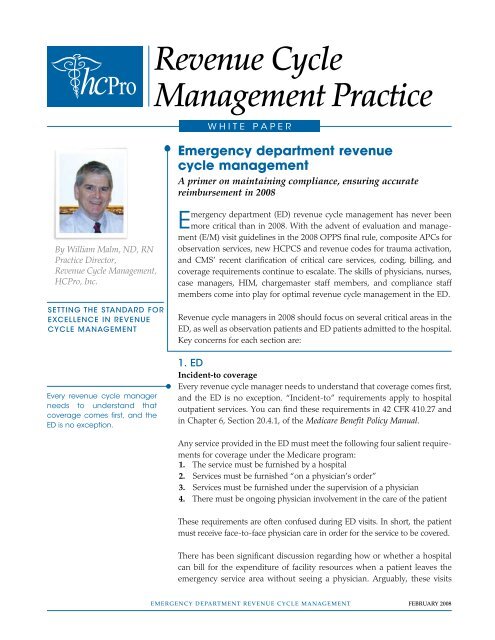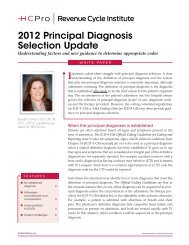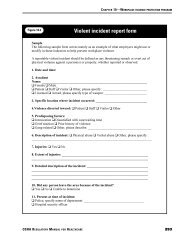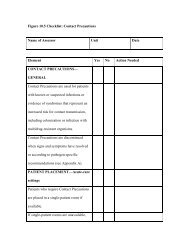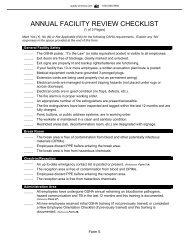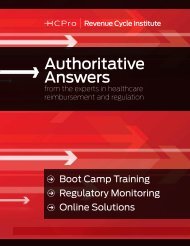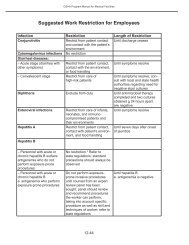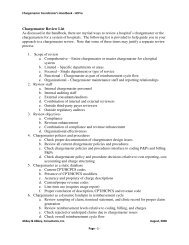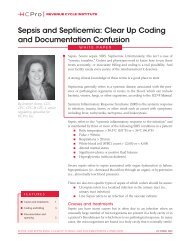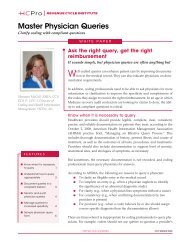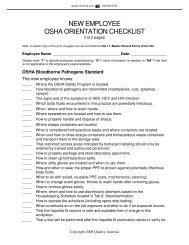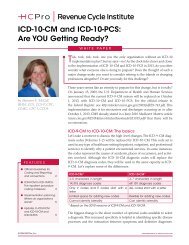Revenue Cycle Management Practice - HCPro Blogs
Revenue Cycle Management Practice - HCPro Blogs
Revenue Cycle Management Practice - HCPro Blogs
Create successful ePaper yourself
Turn your PDF publications into a flip-book with our unique Google optimized e-Paper software.
<strong>Revenue</strong> <strong>Cycle</strong><br />
<strong>Management</strong> <strong>Practice</strong><br />
W h i t e p a p e r<br />
By William Malm, ND, RN<br />
<strong>Practice</strong> Director,<br />
<strong>Revenue</strong> <strong>Cycle</strong> <strong>Management</strong>,<br />
<strong>HCPro</strong>, Inc.<br />
setting the standard for<br />
excellence in revenue<br />
cycle management<br />
Every revenue cycle manager<br />
needs to understand that<br />
coverage comes first, and the<br />
ED is no exception.<br />
Emergency department revenue<br />
cycle management<br />
A primer on maintaining compliance, ensuring accurate<br />
reimbursement in 2008<br />
Emergency department (ED) revenue cycle management has never been<br />
more critical than in 2008. With the advent of evaluation and management<br />
(E/M) visit guidelines in the 2008 OPPS final rule, composite APCs for<br />
observation services, new HCPCS and revenue codes for trauma activation,<br />
and CMS’ recent clarification of critical care services, coding, billing, and<br />
coverage requirements continue to escalate. The skills of physicians, nurses,<br />
case managers, HIM, chargemaster staff members, and compliance staff<br />
members come into play for optimal revenue cycle management in the ED.<br />
<strong>Revenue</strong> cycle managers in 2008 should focus on several critical areas in the<br />
ED, as well as observation patients and ED patients admitted to the hospital.<br />
Key concerns for each section are:<br />
1. ED<br />
Incident-to coverage<br />
Every revenue cycle manager needs to understand that coverage comes first,<br />
and the ED is no exception. “Incident-to” requirements apply to hospital<br />
outpatient services. You can find these requirements in 42 CFR 410.27 and<br />
in Chapter 6, Section 20.4.1, of the Medicare Benefit Policy Manual.<br />
Any service provided in the ED must meet the following four salient requirements<br />
for coverage under the Medicare program:<br />
1. The service must be furnished by a hospital<br />
2. Services must be furnished “on a physician’s order”<br />
3. Services must be furnished under the supervision of a physician<br />
4. There must be ongoing physician involvement in the care of the patient<br />
These requirements are often confused during ED visits. In short, the patient<br />
must receive face-to-face physician care in order for the service to be covered.<br />
There has been significant discussion regarding how or whether a hospital<br />
can bill for the expenditure of facility resources when a patient leaves the<br />
emergency service area without seeing a physician. Arguably, these visits<br />
emergency department revenue cycle management february 2008
Emergency Department <strong>Revenue</strong> <strong>Cycle</strong> <strong>Management</strong> February 2008<br />
do not meet Medicare incident-to coverage guidelines and therefore are<br />
noncovered services. Examples of these types of visits are triage-only and<br />
patients who leave prior to treatment.<br />
Coding and charging for ED visits<br />
In 2007, CMS divided ED visits into two types: Type A and Type B. Medicare<br />
defines a Type A ED as one that is available to provide services 24 hours per<br />
day, seven days per week (this requirement is also listed in the CPT Manual),<br />
and which also meets one or both of the following requirements related to<br />
the Emergency Medical Treatment and Active Labor Act (EMTALA) definition<br />
of a dedicated ED (DED):<br />
1. It is licensed by the state in which it is located under the applicable state<br />
law as an ER or ED<br />
2. It is held out to the public as a place that provides care for emergency<br />
medical conditions on an urgent basis without requiring a previously<br />
scheduled appointment<br />
A Type B ED is identical to a Type A in that it also must meet the EMTALA<br />
requirements and DED definitions. The difference is that a Type B ED is not<br />
open 24 hours per day, seven days per week. Therefore, the key determinant<br />
is the time at which the facility department is scheduled to be open.<br />
You can find further information about the definitions of Type A vs. Type<br />
B EDs in the 2007 OPPS final rule (Federal Register, Vol. 71, No. 226, pp.<br />
68127–68145). You can also find additional clarification in the FAQ section<br />
of the CMS Web site at http://questions.cms.hhs.gov/cgi-bin/cmshhs.<br />
cfg/php/enduser/std_alp.phpp_sid=CduOttTi. Search for FAQ ID numbers<br />
8302–8310.<br />
CMS created five new HCPCS codes to bill Type B ED visits: G0380–G0384<br />
(G0380 is a level one visit, and G0384 is a level five visit). Type A ED visits<br />
continue to be represented by CPT codes 99281–99285.<br />
Under the OPPS, CMS has directed facilities since 2000 to develop and consistently<br />
apply an E/M methodology that accurately reflects the resources<br />
expended by the facility. During that time, several organizations, such as the<br />
American College of Emergency Physicians, the American Health Information<br />
<strong>Management</strong> Association, and the American Hospital Association, have created<br />
templates/guidelines to move forward in the creation of a national-level<br />
determination methodology.<br />
CMS in the 2008 OPPS final<br />
rule stated that it does not<br />
believe that a single, national<br />
E/M model is appropriate at<br />
this time.<br />
However, CMS in the 2008 OPPS final rule stated that it does not believe that<br />
a single, national E/M model is appropriate at this time. CMS did say it feels<br />
that hospitals have achieved this requirement with their own internally developed<br />
systems. CMS continues to explore the potential for national guidelines;<br />
in the meantime it listed 11 E/M criteria that hospitals should follow.<br />
© 2008 by <strong>HCPro</strong>, Inc. Any reproduction is strictly prohibited. For more information call 877/233-8734 or visit www.hcpro.com/revenuecycle.
February 2008 Emergency Department <strong>Revenue</strong> <strong>Cycle</strong> <strong>Management</strong> <br />
The coding guidelines should:<br />
1. Follow the intent of the CPT code descriptor in that the guidelines should<br />
be designed to reasonably relate the intensity of hospital resources to the<br />
different levels of effort represented by the code<br />
2. Be based on hospital facility resources and not on physician resources<br />
3. Be clear to facilitate accurate payments and be usable for compliance<br />
purposes and audits<br />
4. Meet the HIPAA requirements<br />
5. Only require documentation that is clinically necessary for patient care<br />
6. Not facilitate upcoding or gaming<br />
7. Be written or recorded, well-documented, and provide the basis for selection<br />
of a specific code<br />
8. Be applied consistently across patients in the clinic or ED to which they<br />
apply<br />
9. Not change with great frequency<br />
10. Be readily available for FI (or, if applicable, Medicare administrator contractor<br />
[MAC]) review<br />
11. Result in coding decisions that could be verified by other hospital staff, as<br />
well as outside sources<br />
(Source: Federal Register, Vol. 72, No. 227, p. 66805.)<br />
The tone of this message<br />
clearly indicates the potential<br />
for future E/M audits by FIs or<br />
MACs.<br />
The tone of this message clearly indicates the potential for future E/M audits<br />
by FIs or MACs. Additionally, the message gives guidance that the facility<br />
should audit the coding assignment of the level of care (e.g., CPT codes<br />
99281–99285).<br />
It further states that the coding guidelines should not require additional<br />
effort in regard to documentation but should be consistently applied and not<br />
facilitate gaming or upcoding.<br />
Many facilities still lack well-written guidelines. The result is that frequently<br />
within the same department, personnel do not consistently apply the guidelines.<br />
This results in inaccurate code assignments.<br />
<strong>Revenue</strong> cycle management committees should review these 11 points to<br />
ensure that their ED level assignments comply with these guidelines.<br />
Coding and charging for critical care<br />
Critical care level visits have been a source of controversy since the advent<br />
of the OPPS. CMS specified facility critical care requirements in the 2007<br />
OPPS final rule, stating, “The 30-minute minimum requirement has always<br />
applied and will continue to apply for [calendar year] 2007 and beyond. As<br />
is currently the case, the hospital can bill the appropriate clinic or emergency<br />
department visit code if fewer than 30 minutes of critical care is provided.”<br />
(Source: Federal Register, Vol. 71, No. 226, p. 68134.)<br />
© 2008 by <strong>HCPro</strong>, Inc. Any reproduction is strictly prohibited. For more information call 877/233-8734 or visit www.hcpro.com/revenuecycle.
Emergency Department <strong>Revenue</strong> <strong>Cycle</strong> <strong>Management</strong> February 2008<br />
In other words, in order for the hospital to report code 99291, the physician<br />
must provide at least 30 minutes of critical care. Hospitals can report critical<br />
care greater than 74 minutes in duration using code 99292, but CMS will<br />
package the payment.<br />
Additionally, CMS has provided guidance stating that critical care should<br />
follow the “intent of the CPT code,” but it has fallen short of stating whether<br />
hospitals should follow physician requirements or what is contained within<br />
the hospital’s resource consumption. CMS FAQ 8312 states the following:<br />
Under the OPPS, the time that can be reported as critical care is the time<br />
spent by a physician and/or hospital staff engaged in active face-to-face critical<br />
care of a critically ill or critically injured patient. If the physician and<br />
hospital staff or multiple hospital staff members are simultaneously engaged<br />
in this active face-to-face care, the time involved can only be counted once.<br />
Based on this FAQ, from a revenue cycle standpoint, time documentation<br />
should be paramount to ensure that hospitals meet these requirements.<br />
On December 19, 2007, CMS<br />
shocked the provider/facility<br />
community with the release<br />
of FAQs 8809 and 8813.<br />
On December 19, 2007, CMS shocked the provider/facility community<br />
with the release of FAQs 8809 and 8813. Those FAQs state that facilities<br />
must follow the strict definition of CPT code 99291. Most facilities currently<br />
charge separately for specific services rendered during the provision of critical<br />
care. Now, CMS expects that hospitals should not separately bill certain<br />
specified CPT codes (e.g., chest x-rays, ventilator management, pulse oximetry,<br />
gastric intubation, transcutaneous pacing) as it considers these services<br />
to be included in the provision of critical care.<br />
Because hospitals previously billed these services separately (based on<br />
guidance in another CMS FAQ from September 2000), it is doubtful that<br />
the amount CMS reimburses hospitals for 99291 includes the cost of these<br />
items. This new guidance is now a significant compliance concern for most<br />
facilities that have charged separately for these items. Without any further<br />
guidance, facilities should immediately cease the practice of charging<br />
separately for these items and look for upcoming guidance from CMS. You<br />
can find these FAQs at the CMS Web site at http://questions.cms.hhs.gov/<br />
cgi-bin/cmshhs.cfg/php/enduser/std_alp.phpp_sid=RXlShDMi.<br />
Coding and charging for trauma activation<br />
Trauma activation continues to be somewhat difficult for facilities to implement<br />
because CMS maintains strict rules about which hospitals can report<br />
trauma activation codes. According to the 2007 OPPS final rule:<br />
The revenue codes series 068x can only be used by trauma centers/hospitals<br />
as licensed or designated by the state or local government authority<br />
authorized to do so, or as verified by the American College of Surgeons.<br />
Different subcategory codes are reported by the designated Level 1–4<br />
hospital trauma centers. Only a patient for whom there has been prehospital<br />
notification based on triage information by prehospital caregivers,<br />
© 2008 by <strong>HCPro</strong>, Inc. Any reproduction is strictly prohibited. For more information call 877/233-8734 or visit www.hcpro.com/revenuecycle.
February 2008 Emergency Department <strong>Revenue</strong> <strong>Cycle</strong> <strong>Management</strong> <br />
who meet either local, state, or American College of Surgeons field triage<br />
criteria, or are delivered by interhospital transfers, and are given the appropriate<br />
team response can be billed a trauma activation charge. (Source:<br />
Federal Register, Vol. 71, No. 226, p. 68134.)<br />
If the facility meets the above requirements and also meets the requirements<br />
for critical care (i.e., CPT code 99291), CMS instructs the facility to report a<br />
068x revenue code along with trauma activation HCPCS code G0390.<br />
However, if the facility does not meet the critical care time requirements, the<br />
facility should bill two distinct lines on the UB-04. The first line is revenue<br />
code 068x without a HCPCS code, and the charge should represent the<br />
resources utilized for trauma activation. Line two should be the ED level of<br />
care as documented and billed according to the facility documentation and<br />
coding guidelines.<br />
You can find further information about trauma activation at the CMS<br />
FAQ site (http://questions.cms.hhs.gov/cgi-bin/cmshhs.cfg/php/enduser/std_alp.<br />
phpp_sid=RXlShDMi). Look for FAQ ID numbers 8313 and 8314.<br />
Coding and charging for infusions and injections<br />
Infusions and injections have taken center stage in the ED revenue cycle.<br />
In fact, they’ve taken such a high priority that the remainder of the revenue<br />
cycle management of ED services has taken a back seat, and providers may<br />
suffer lost charges or compliance concerns as a result.<br />
Significant guidance has been provided about infusions and injections and<br />
is so voluminous that we are prevented from including it within this white<br />
paper. We would recommend that a member of the revenue cycle management<br />
committee prepare educational materials for the staff based on CMS<br />
guidance. Additionally, significant commercially prepared documents and<br />
tools exist to assist the coding and nursing staff in appropriate documentation<br />
and coding of these procedures. You can find authoritative guidance in<br />
the CPT Manual and in CPT Assistant, which you can obtain directly from<br />
the AMA.<br />
Orthotics and prosthetics<br />
can be billed by a facility<br />
with or without a durable<br />
medical equipment (DME)<br />
license.<br />
Coding and charging for orthotics and prosthetics<br />
Orthotics and prosthetics can be billed by a facility with or without a durable<br />
medical equipment (DME) license. However, many facilities miss these<br />
reimbursable supplies because they are under the impression that they are<br />
required to obtain a DME license in order to bill them.<br />
You can find orthotic and prosthetic guidance in Chapter 20 of the Medicare<br />
Internet Only Manual 100-04 (Claims Processing Manual). This source states<br />
that “SNFs, CORFs, OPTs, and hospitals bill the FI for prosthetic/orthotic<br />
devices, supplies, and covered outpatient DME and oxygen” (refer to Section<br />
40). The revenue cycle management committee should review its hospital<br />
© 2008 by <strong>HCPro</strong>, Inc. Any reproduction is strictly prohibited. For more information call 877/233-8734 or visit www.hcpro.com/revenuecycle.
Emergency Department <strong>Revenue</strong> <strong>Cycle</strong> <strong>Management</strong> February 2008<br />
chargemaster to ensure that orthotics such as Philadelphia collars, foam cervical<br />
collars, knee immobilizers, air casts, and other similar supplies are defined<br />
as an orthotic per the “L” HCPCS code section of the HCPCS Level II Manual.<br />
The facility should inventory these items and ensure that they are included<br />
within the chargemaster and that ED staff members charge for them.<br />
Pharmaceuticals<br />
EDs struggle with the charge capture and billing of pharmaceuticals. This is<br />
a particular concern when it comes to high-cost pharmaceuticals.<br />
Common problems include<br />
errors in the number of units of<br />
a medication billed as defined<br />
by the HCPCS J code.<br />
Common problems include errors in the number of units of a medication<br />
billed as defined by the HCPCS J code. The HCPCS J codes define how<br />
many milligrams or units are included in the code. The total dose ordered<br />
and administered should equal the number specified within the J code. This<br />
is a constant area of concern. Our practice finds significant lost charges<br />
because the units of service on the UB-04 do not represent the dosage<br />
delivered. This is particularly problematic with high-cost drugs. Note that,<br />
although CMS only provides separate reimbursement for some drugs, the<br />
agency still recommends that hospitals report all drugs with a corresponding<br />
HCPCS J code on the claim.<br />
The other significant problem with pharmaceuticals involves self-administered<br />
medications. Hospitals should report self-administered drugs on the<br />
claim in the noncovered column because they represent patient liability.<br />
Hospital pharmacy departments often consider the following medications<br />
to always be self-administered:<br />
■ Pills<br />
■ Capsules<br />
■ Inhalants<br />
■ Topicals<br />
However, the problem is that many of these types of drugs are covered and<br />
are not a patient liability because they meet the “integral to” requirements<br />
and are therefore a covered supply. (Source: Medicare Claims Processing<br />
Manual, Chapter 4, Section 10.4, and Program Memorandum A-02-129).<br />
Examples of self-administered drugs that are a covered supply are certain<br />
sedatives, eye drops, and contrast media. Exercise caution to avoid this<br />
chargemaster-driven dilemma.<br />
Widespread packaging<br />
of services, including<br />
observation, presents<br />
a new operational and<br />
financial wrinkle for<br />
hospitals to consider.<br />
2. Observation<br />
Composite APCs<br />
One of the most significant changes to the OPPS since its inception took<br />
effect January 1. Widespread packaging of services, including observation,<br />
presents a new operational and financial wrinkle for hospitals to consider.<br />
In the past, patients that had diagnoses of chest pain, congestive heart failure,<br />
or asthma were eligible for separate observation APC payment. This<br />
© 2008 by <strong>HCPro</strong>, Inc. Any reproduction is strictly prohibited. For more information call 877/233-8734 or visit www.hcpro.com/revenuecycle.
February 2008 Emergency Department <strong>Revenue</strong> <strong>Cycle</strong> <strong>Management</strong> <br />
year, CMS eliminated these three diagnostic requirements, making any<br />
patient eligible for potential observation payment.<br />
But other requirements exist. Hospitals won’t receive separate APC payment<br />
unless they bill a level four, five, or critical care E/M level in<br />
conjunction with observation, or if staff members directly admit the patient<br />
to observation. And as always, the patient must receive at least eight hours<br />
of observation care in order for hospitals to qualify for separate payment<br />
Payment for observation now falls under the following two composite APCs:<br />
■ APC 8002: Level I Extended Assessment & <strong>Management</strong><br />
Composite<br />
■ APC 8003: Level II Extended Assessment & <strong>Management</strong><br />
Composite<br />
More than ever, hospitals must ensure that their observation documentation<br />
is complete and compliant. Observation admission notes, history<br />
and physicals, and consults all must be documented. Include the time the<br />
patient was placed in an observation bed and ensure that the physician<br />
order is timed and dated. Payment of composite APCs also depends upon<br />
good documentation of your level of service, using the 11 E/M criteria<br />
points detailed above.<br />
Many hospitals are under<br />
the mistaken belief that<br />
any and all ED services<br />
performed prior to an<br />
inpatient stay must be<br />
rolled into the subsequent<br />
inpatient admission.<br />
3. Inpatient admits<br />
Three Day Payment Window Rule and ED services<br />
The Three Day Payment Window Rule represents both a compliance risk<br />
and a significant source of lost revenue for hospitals. Many hospitals are<br />
under the mistaken belief that any and all ED services performed prior to an<br />
inpatient stay must be rolled into the subsequent inpatient admission.<br />
That’s not the case. In fact, a significant volume of these charges are actually<br />
separately billable (and separately payable) by Medicare on an outpatient<br />
claim. This error typically occurs because a hospital’s operational processes<br />
fail to properly distinguish between diagnostic and nondiagnostic services<br />
(which are treated differently under the rule). At other times, hospitals<br />
mistakenly bill for outpatient services on an outpatient claim when these<br />
services should be moved over to the inpatient claim—an error that poses<br />
a significant compliance risk.<br />
The following diagnostic services (including clinical diagnostic laboratory<br />
tests), when provided to a beneficiary by the admitting hospital within<br />
three days prior to and including the date of the beneficiary’s admission,<br />
are considered inpatient services. Under the Three Day Payment Window<br />
Rule, you must include services with the following revenue codes in the<br />
inpatient payment:<br />
■ 0254—Drugs incident to other diagnostic services<br />
■ 0255—Drugs incident to radiology<br />
© 2008 by <strong>HCPro</strong>, Inc. Any reproduction is strictly prohibited. For more information call 877/233-8734 or visit www.hcpro.com/revenuecycle.
Emergency Department <strong>Revenue</strong> <strong>Cycle</strong> <strong>Management</strong> February 2008<br />
■<br />
■<br />
■<br />
■<br />
■<br />
■<br />
■<br />
■<br />
■<br />
■<br />
■<br />
■<br />
■<br />
■<br />
■<br />
■<br />
■<br />
030X—Laboratory<br />
031X—Laboratory pathological<br />
032X—Radiology diagnostic<br />
0341—Nuclear medicine, diagnostic<br />
035X—CT scan<br />
0371—Anesthesia incident to radiology<br />
0372—Anesthesia incident to other diagnostic services<br />
040X—Other imaging services<br />
046X—Pulmonary function<br />
0471—Audiology diagnostic<br />
048X—Cardiology, with HCPCS codes 93015, 93307, 93308, 93320,<br />
93501—93503, 93505, 93510, 93526, 93541, 93542, 93543, 93544–<br />
93552, 93561, or 93562<br />
053X—Osteopathic services<br />
061X—MRT<br />
062X—Medical/surgical supplies, incident to radiology or other<br />
diagnostic services<br />
073X—EKG/ECG<br />
074X—EEG<br />
092X—Other diagnostic services<br />
Additionally, all nondiagnostic services related to a patient’s hospital admission<br />
that are provided by the admitting hospital to the patient during the<br />
three days preceding and including the date of the patient’s admission are<br />
also included in the inpatient payment, but with one critical caveat—there<br />
must be an exact match (all digits) between the ICD-9-CM principal diagnosis<br />
code assigned for both the preadmission services and the inpatient stay. If<br />
there is not an exact match, a hospital may bill all nondiagnostic preadmission<br />
services to Part B on an outpatient claim.<br />
Specific to the ED, CMS considers revenue code 045x to be nondiagnostic in<br />
nature. Therefore, these services are not included in the list of revenue codes<br />
that must be rolled into the inpatient admission. This means that if the principal<br />
diagnosis on the emergency record is not an exact match to the principal<br />
diagnosis for the inpatient admission, a hospital can bill these ED services<br />
separately and receive compliant separate reimbursement.<br />
We recommend that you review the Three Day Payment Window Rule in the<br />
Medicare Internet Only Manual 100-04 (Claims Processing Manual), Chapter 3,<br />
Section 40.3, titled “Outpatient Services Treated as Inpatient.” ■<br />
Note: If you have a question about ED coding or billing, send an e-mail to<br />
William Malm at revenuecyclemanagement@hcpro.com.<br />
© 2008 by <strong>HCPro</strong>, Inc. Any reproduction is strictly prohibited. For more information call 877/233-8734 or visit www.hcpro.com/revenuecycle.


